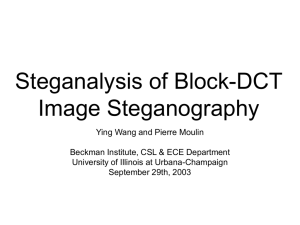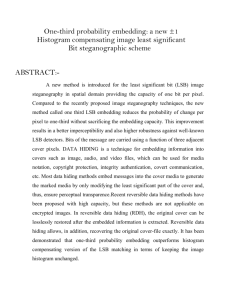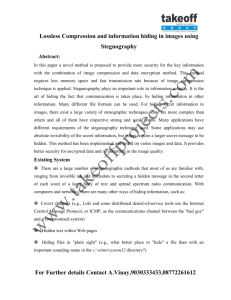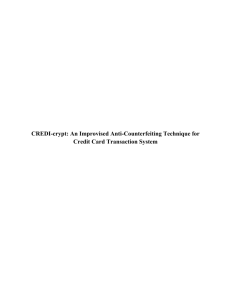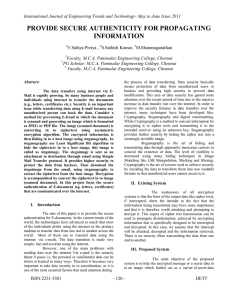Document 13135408
advertisement
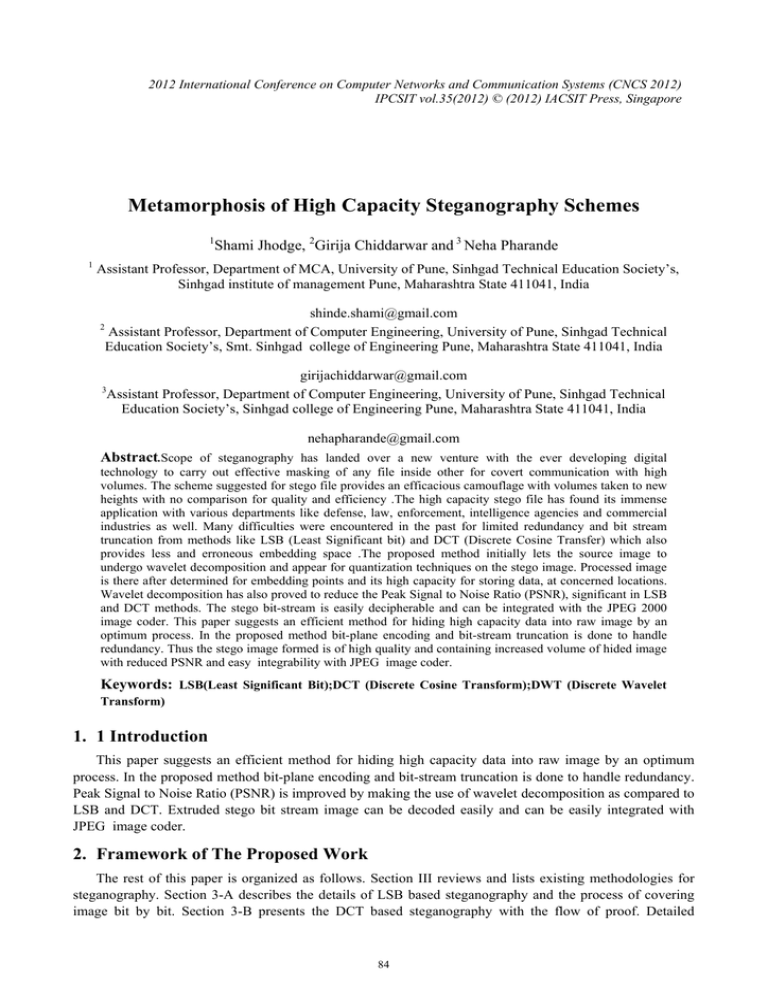
2012 International Conference on Computer Networks and Communication Systems (CNCS 2012) IPCSIT vol.35(2012) © (2012) IACSIT Press, Singapore Metamorphosis of High Capacity Steganography Schemes 1 1 Shami Jhodge, 2Girija Chiddarwar and 3 Neha Pharande Assistant Professor, Department of MCA, University of Pune, Sinhgad Technical Education Society’s, Sinhgad institute of management Pune, Maharashtra State 411041, India 2 shinde.shami@gmail.com Assistant Professor, Department of Computer Engineering, University of Pune, Sinhgad Technical Education Society’s, Smt. Sinhgad college of Engineering Pune, Maharashtra State 411041, India 3 girijachiddarwar@gmail.com Assistant Professor, Department of Computer Engineering, University of Pune, Sinhgad Technical Education Society’s, Sinhgad college of Engineering Pune, Maharashtra State 411041, India nehapharande@gmail.com Abstract.Scope of steganography has landed over a new venture with the ever developing digital technology to carry out effective masking of any file inside other for covert communication with high volumes. The scheme suggested for stego file provides an efficacious camouflage with volumes taken to new heights with no comparison for quality and efficiency .The high capacity stego file has found its immense application with various departments like defense, law, enforcement, intelligence agencies and commercial industries as well. Many difficulties were encountered in the past for limited redundancy and bit stream truncation from methods like LSB (Least Significant bit) and DCT (Discrete Cosine Transfer) which also provides less and erroneous embedding space .The proposed method initially lets the source image to undergo wavelet decomposition and appear for quantization techniques on the stego image. Processed image is there after determined for embedding points and its high capacity for storing data, at concerned locations. Wavelet decomposition has also proved to reduce the Peak Signal to Noise Ratio (PSNR), significant in LSB and DCT methods. The stego bit-stream is easily decipherable and can be integrated with the JPEG 2000 image coder. This paper suggests an efficient method for hiding high capacity data into raw image by an optimum process. In the proposed method bit-plane encoding and bit-stream truncation is done to handle redundancy. Thus the stego image formed is of high quality and containing increased volume of hided image with reduced PSNR and easy integrability with JPEG image coder. Keywords: LSB(Least Significant Bit);DCT (Discrete Cosine Transform);DWT (Discrete Wavelet Transform) 1. 1 Introduction This paper suggests an efficient method for hiding high capacity data into raw image by an optimum process. In the proposed method bit-plane encoding and bit-stream truncation is done to handle redundancy. Peak Signal to Noise Ratio (PSNR) is improved by making the use of wavelet decomposition as compared to LSB and DCT. Extruded stego bit stream image can be decoded easily and can be easily integrated with JPEG image coder. 2. Framework of The Proposed Work The rest of this paper is organized as follows. Section III reviews and lists existing methodologies for steganography. Section 3-A describes the details of LSB based steganography and the process of covering image bit by bit. Section 3-B presents the DCT based steganography with the flow of proof. Detailed 84 analysis of proposed DWT method is carried out in section 4 . Experimental comparison is demonstrated in Section 5 . Proposed work from implementation point of view is described in section VI and Section VII concludes the paper. 3. Existing Methodology LSB based steganography method has higher capacity of hiding the data but at the cost of quality of image. DCT based steganography gives more quality of image than LSB substitution method but don’t able to support high capacity to hide data. Moreover in DCT quantized image is not processed to recover the loss of image. DWT based steganography is a advanced data hiding method, which gives better quality of image and as well as it supports higher capacity to hide the data as compared to LSB substitution and DCT based steganography method. The complexity of the procedure is increased. 3.1. A LSB based steganography LSB substitution method is one of the common techniques for steganography It is based on manipulating the least significant bit (LSB) planes by directly replacing the LSBs of the cover-image with the message bits LSB methods typically achieve high capacity but low quality. 1) Algorithm for LSB substitution Algorithm to embed text message[1]:Step 1: Read the cover image and text message which is to be hidden in the cover image. Step 2: Convert text message in binary. Step 3: Calculate LSB of each pixels of cover image. Step 4: Replace LSB of cover image with each bit of secret message one by one. Step 5: Write stego image .Algorithm to retrieve text message [1]:- Step 1: Read the stego image. Step 2: Calculate LSB of each pixels of stego image. Step 3: Retrieve bits and convert each 8 bit into character. 3.2. B DCT based steganography DCT coefficients are used for JPEG compression. It separates the image into parts of differing importance. It transforms a signal or image from the spatial domain to the frequency domain. 1) Algorithm for DCT Based Steganography Algorithm to embed text message [1]:Step 1: Read cover image. Step 2: Read secret message and convert it in binary. Step 3: The cover image is broken into 8×8 block of pixels. Step 4: Working from left to right, top to bottom subtract 128 in each block of pixels. Step 5: DCT is applied to each block. Step 6: Each block is compressed through quantization table. Step 7: Calculate LSB of each DC coefficient and replace with each bit of secret message. Write stego image. Algorithm to retrieve text message [1]:Step 1: Read stego image. Step 2: Stego image is broken into 8×8 block of pixels. Step 3: Working from left to right, top to bottom subtract 128 in each block of pixels. Step 4: DCT is applied to each block. Step 5: Each block is compressed through quantization table. Step 6: Calculate LSB of each DC coefficient. Step 7: Retrieve and convert each 8 bit into character 85 4. Dwt Based Steganography For JPEG2000 compressed images, limited redundancy and bit stream truncation makes it difficult to hide information. After analyzing the challenge of covert communication in JPEG2000 image it is necessary to have a steganography scheme to hide high volumetric data into JPEG2000 bit stream. In order to avoid affection of bit stream truncation. The method uses bit-plane encoding procedure to solve the problem due to bit stream truncation. Moreover, the embedding points and their intensity are adjusted on image adaptively based on redundancy evaluation to increase hiding capacity. First, the capacity of each embedding point is calculated independently to get a quantitative result measured by bit .A candidate embedding point would be removed if it has an evaluated quantization redundancy less than two. To deal with steganography it is better to compress the image, as same that deed in JPEG system by DCT but not in LSB substitution method. Figure 1 and figure 2 [2] shows the process model to cover the image by DWT. Figure 1 Process model of information hiding using DWT. Figure 2 message Extraction A Wavelet Decomposition Decomposes the signals into ban of energy which is sampled at different rate. Selected rate tries to preserve the signal information. Minimizes sampling rate i.e. resolution of each sub band. It makes the use of low pass and high pass filter to generate wavelet coefficients. Figure 3 [ 3] shows a one level decomposition using the two-dimensional DWT. these steps result in four classes of coefficients: the(HH) coefficients represent diagonal features of the image, whereas (HL and LH) reflect vertical and horizontal information. At the coarsest level, we also keep low pass coefficients (LL) Figure 3 Decomposition of image using filters 86 B Quantization After wavelet decomposition the transformed image is given as input to Quantization which produces the image with reduced storage volume at the cost of lossy compression depending on the Q factor. C Bit Plane Encoding and Rate distortion Optimization Bit plane coding is performed to achieve lossless data compression. Here the image components are arranged in zigzag order to apply run length encoding to group similar frequencies together. The algorithm used for bit plane coding is Embedded Block Coding with Optimized Truncation (EBCOT). Figure 4 Two steps of EBCOT algorithm ,Tire 1 and Tire 2 1) Tire 1 Step 1 Code-blocks are partitioned into bit-planes, where most significant bits are partitioned together Step 2 Bit-planes are finally encoded once in one of three coding passes: i) Cleanup pass ii) Significance propagation pass . iii) Magnitude refinement pass. Example : Consider following are the magnitude to perform bit plane coding [4] Figure 5. Magnitudes of image Figure 6. Coding of the first bit-plane (Bit plane n=5) To perform clean up pass, the highest magnitude coefficient is 61. There are thus 6 magnitude bit-planes in this code-block . Significant coefficients must be found before their magnitude can be refined. The range is from 32 to 64.In the case of coefficient (0,2), as no neighbor is signed, the context is (SC0). The predicted sign is positive. This prediction is not correct thus the symbol 1 is output in the (SC0) context. Symbols (1,2) to (3,2) remains in the column j = 2. As the coder is no more in the Run-Length mode, the ZC primitive is used. Coefficient (1,2) has only one significant neighbor: the coefficient (0,2). Moreover, coefficient (1,2) is not significant at the bit-plane n = 5. The symbol 0 is thus output in the (ZC3) context. Table 1: sign prediction and context of the SC primitive Table 2: context of zc primitive. “x” means any value 87 Figure 7Operation performed on bit plane=4 2) Tire 2 (Rate Distortion Optimization) Figure 8 Significant propagation pass on bit plane n=4 The output of coding pass is given to rate distortion optimizer to produce valid truncation points of each code block. D Determine Embedding Points Candidate embedding points. = wavelet coefficients > threshold. On the basis of redundancy evaluation embedding points and intensity are adjusted. 5. Comparison of LSB, DCT, DWT with Working Methodology LSB based steganography method has higher capacity of hiding the data but at the cost of quality of image. DCT based steganography gives more quality of image than LSB substitution method but don’t able to support high capacity to hide data. Moreover in DCT quantized image is not processed to recover the loss of image. DWT based steganography is a advanced data hiding method, which gives better quality of image and as well as it supports higher capacity to hide the data as compared to LSB substitution and DCT based steganography method. The complexity of the procedure is increased. 6. Proposed Work From Implementation Point Of View JPEG 2000 image which is accounted for its ubiquitous quality image , limits the scope of steganography (image hiding) due to its restriction for bit-stream truncation and lower redundancy rate. Hence to overcome with this , and to abide by JEPG 2000 norms the reference paper [2] proposes primary bit- plane coding to locate embedding points for hiding cover image with no quality compromise . But the stego image just formed carries noise or garbage values along with some unwanted values of cover image itself which has been engrossed earlier , hence to remove this a secondary bit plane coding is done. This paper suggests the application of steganography where in the cover image is mediocre quality as compare to JEPG 2000 and the hiding image quality is situation based ,hence to find the embedding points DWT based bit-plane encoding procedure which is done only once to get the required effective embedding points. This saves substantial amount of processing time and the complexity of program is highly reduced , this proves the significance of proposed method ,in depicted paper in application such as biometric authentication for net banking were data is required to pass through an unsecured channel to the server. 7. Conclusions From above findings it was revealed that the DWT based steganography method per seeds the two previously used data hiding methods i.e. LSB and DCT in terms of quality as well as supporting high volume hiding data, space. DWT method compresses the source image by series of processes like wavelet decomposition quantization bit plane encoding and rate distortion optimization .This compressed image is later worked upon for redundancy magnitude which takes into account the self contrast visual masking effect for deciding the message embedding points for data hiding and hence produces the final high volume ,high quality stego image 8 References [1] Dr. Ekta Walia a, Payal Jainb, Navdeepc. An Analysis of LSB & DCT based Steganography Vol. 10 Issue 1 (Ver 1.0), April 2010 Global Journal of Computer Science and Technology [2] Liang Zhang, Haili Wang, and Renbiao Wu, Senior Member, IEEE A High-Capacity Steganography Scheme 88 for JPEG2000 Baseline System IEEE TRANSACTIONS ON IMAGE PROCESSING, VOL. 18, NO. 8, AUGUST 2009 [3] Mohamed I. Mahmoud, Moawad I. M. Dessouky, Salah Deyab, and Fatma H. Elfouly Wavelet Data Hiding using Achterbahn-128 on FPGA Technology Faculty of Electronic Engineering, Menouf, Egypt. [4] Xavier Delaunay d.xav@free.fr EBCOT coding passes explained on a detailed example. 89 90

